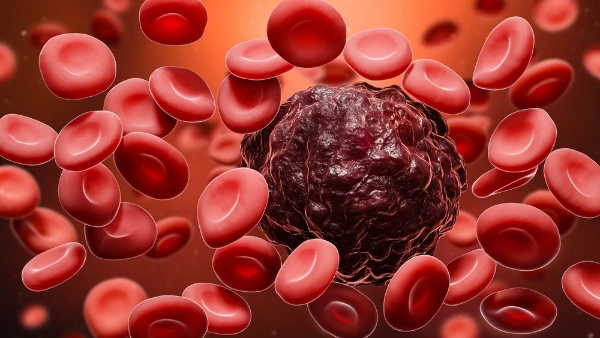Leukemia is it genetic

If you tested your DNA with a personal genomics service like 23andMe, AncestryDNA, FamilyTreeDNA, MyHeritage or another testing company, you can learn more about your risk factors for hundreds of diseases. By clicking the button above ⬆️, you can upload your raw DNA data file and receive a personalized 250-page health report with research links that is the most comprehensive.
Acute myeloid leukemia (AML) is a diverse cancer that primarily impacts individuals aged 60 and above. The identification, prediction, and management of AML have evolved from a condition that was previously defined, categorized, and staged solely on histological features to one that is mainly classified by genetic, genomic, and molecular traits.
Individuals who have familial acute myeloid leukemia with mutated CEBPA experience a deficiency of white blood cells, which causes leukopenia and makes them more vulnerable to infections. Additionally, they may suffer from anemia due to a low count of red blood cells, leading to fatigue and weakness. Thrombocytopenia, a decrease in the number of platelets, can also occur, resulting in abnormal bleeding and easy bruising. Other possible symptoms of this disorder include weight loss and fever.
Most individuals with familial acute myeloid leukemia with mutated CEBPA have a mutation in both copies of the CEBPA gene. While one copy is inherited, the second mutation is acquired and only found in leukemia cells. This type of mutation, known as a somatic mutation, typically reduces the DNA-binding ability of CCAAT enhancer-binding protein alpha. However, the impact of this second mutation on the development of acute myeloid leukemia remains uncertain.
Important prognostic markers and potential therapeutic targets are represented by genetic mutations such as NPM1, FLT3, CEBPA, TET-2, c-KIT, DNMT3A, IDH, RUNX1, AXSL1, WT1, and Rasgene mutations.
The performance of cytogenetic studies on bone marrow is essential in patients with AML as it aids in the identification of the leukemia, determining the severity of the disease, response to treatment, and prognosis. A prime example is the detection of t(15;17), a translocation between chromosomes 15 and 17, which is linked to the diagnosis of APL, a subtype of AML that requires distinct treatment and monitoring compared to other subtypes.
In AML, FLT3 is frequently mutated and is found to be activated in approximately one-third of cases. About 25% of AML cases exhibit internal tandem duplications (ITDs) in the juxtamembrane domain of FLT3, while others have mutations in the activation loop of the gene. Patients with FLT3-ITD mutations generally have a worse prognosis, particularly in those with normal cytogenetics.
Although molecular markers like IDH1, IDH2, and DNMT3A have been proposed as indicators of risk and treatment response, their correlation with the risk of relapse or mortality remains unclear, and tests for these markers are not commonly accessible.
Follow the link of the selected polymorphism to read a brief description of how the selected polymorphism affects Cancer of the hematopoietic system and see a list of existing studies.
SNP polymorphisms related to the topic Cancer of the hematopoietic system:
| rs7089424 | Variations in 7p12.2 and 10q21.2 affect the risk of childhood acute lymphoblastic leukaemia. |
| rs872071 | The IRF4 rs872071 polymorphism causes susceptibility to chronic lymphocytic leukaemia, Hodgkin's lymphoma, skin cancer and haematological malignancies. |
| rs4132601 | The IKZF1 rs4132601 polymorphism causes susceptibility to acute lymphoblastic leukaemia. |
| rs11978267 | The IKZF1 allele predisposes to childhood acute lymphoblastic leukaemia. |
| rs16754 | Single nucleotide polymorphism rs16754 of the WT1 gene is associated with acute myeloleukaemia in children. |
| rs1801282 | Peroxisome proliferator-activated receptor gamma gene variation on the progression of type 2 diabetes and obesity. Also higher risk of cardiovascular disease with a diet high in saturated fat. |
| rs2239633 | CEBPE polymorphism increases the risk of acute lymphoblastic leukaemia in children. |
| rs1800566 | Antioxidant defence enzyme gene: possible role in protection against carcinogenesis and toxicity by dietary antioxidant intake. |
| rs10821936 | A variant of the ARID5B gene is associated with the development of acute lymphoblastic leukaemia in Mexican children. |
| rs11083846 | A variant of genetic predisposition to chronic lymphocytic leukaemia. |
| rs735665 | 50% higher risk of chronic lymphocytic leukaemia. |
| rs2395185 | |
| rs4129267 | |
| rs4537545 | |
| rs17505102 | |
| rs563507 | |
| rs674313 | |
| rs4987852 | |
| rs305061 | |
| rs2466035 | |
| rs13397985 | |
| rs2511714 | |
| rs31490 | |
| rs4406737 | |
| rs6858698 | |
| rs210134 | |
| rs9273012 | |
| rs7944004 | |
| rs1439287 | |
| rs4368253 | |
| rs1044873 | |
| rs17246404 | |
| rs11022157 | |
| rs757978 | |
| rs210142 | |
| rs1679013 | |
| rs9273363 | |
| rs909253 | |
| rs391023 | |
| rs11636802 | |
| rs391525 | |
| rs3769825 | |
| rs2456449 | |
| rs926070 | |
| rs9378805 | |
| rs2236256 | |
| rs898518 | |
| rs17483466 | |
| rs7176508 | |
| rs13401811 | |
| rs76428106 | |
| rs20541 | |
| rs35602083 | |
| rs2075726 | |
| rs1036935 | |
| rs2858870 | |
| rs9268528 | |
| rs9268542 | |
| rs6903608 | |
| rs204999 | |
| rs501764 | |
| rs2069757 | |
| rs2248462 | |
| rs27524 | |
| rs444929 | |
| rs7745098 | |
| rs1860661 | |
| rs1432295 | |
| rs11249433 | |
| rs796065343 | |
| rs1057519753 | |
| rs77375493 | |
| rs121913459 | |
| rs121913461 | |
| rs121913237 | |
| rs662463 | |
| rs924607 | |
| rs361525 | |
| rs2239704 | |
| rs6691170 | |
| rs1801274 | |
| rs10936599 | |
| rs3806624 | |
| rs2019960 | |
| rs61756766 | |
| rs3731217 | |
| rs1800682 | |
About The Author
Li DaliLi Dali, a National Foundation for Outstanding Youth Fund recipient, is a researcher at the School of Life Sciences in East China Normal University. He earned his PhD in genetics from Hunan Normal University in 2007 and conducted collaborative research at Texas A&M University during his doctoral studies. Li Dali and his team have optimized and innovated gene editing technology, leading to the establishment of a world-class system for constructing gene editing disease models.


